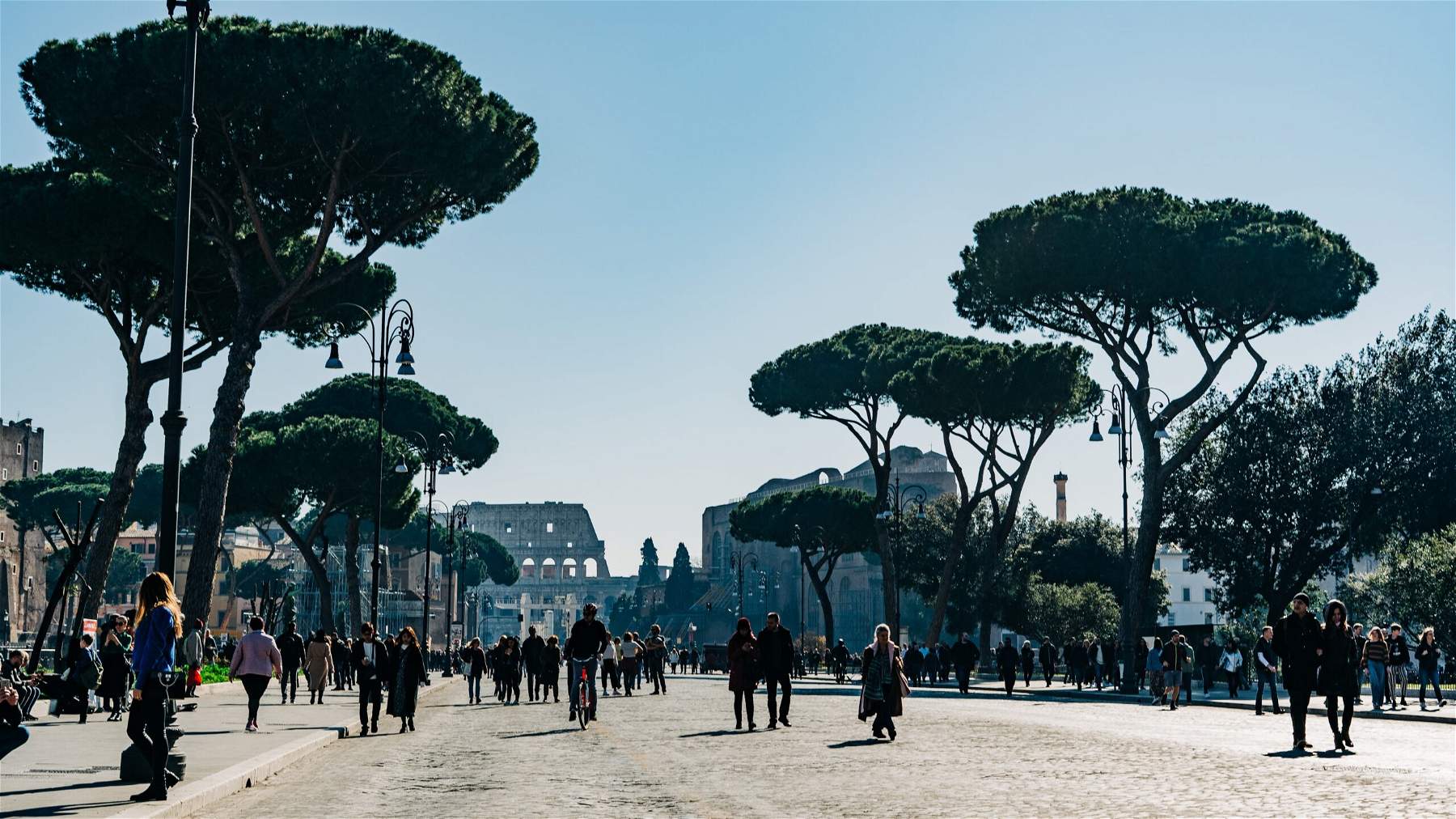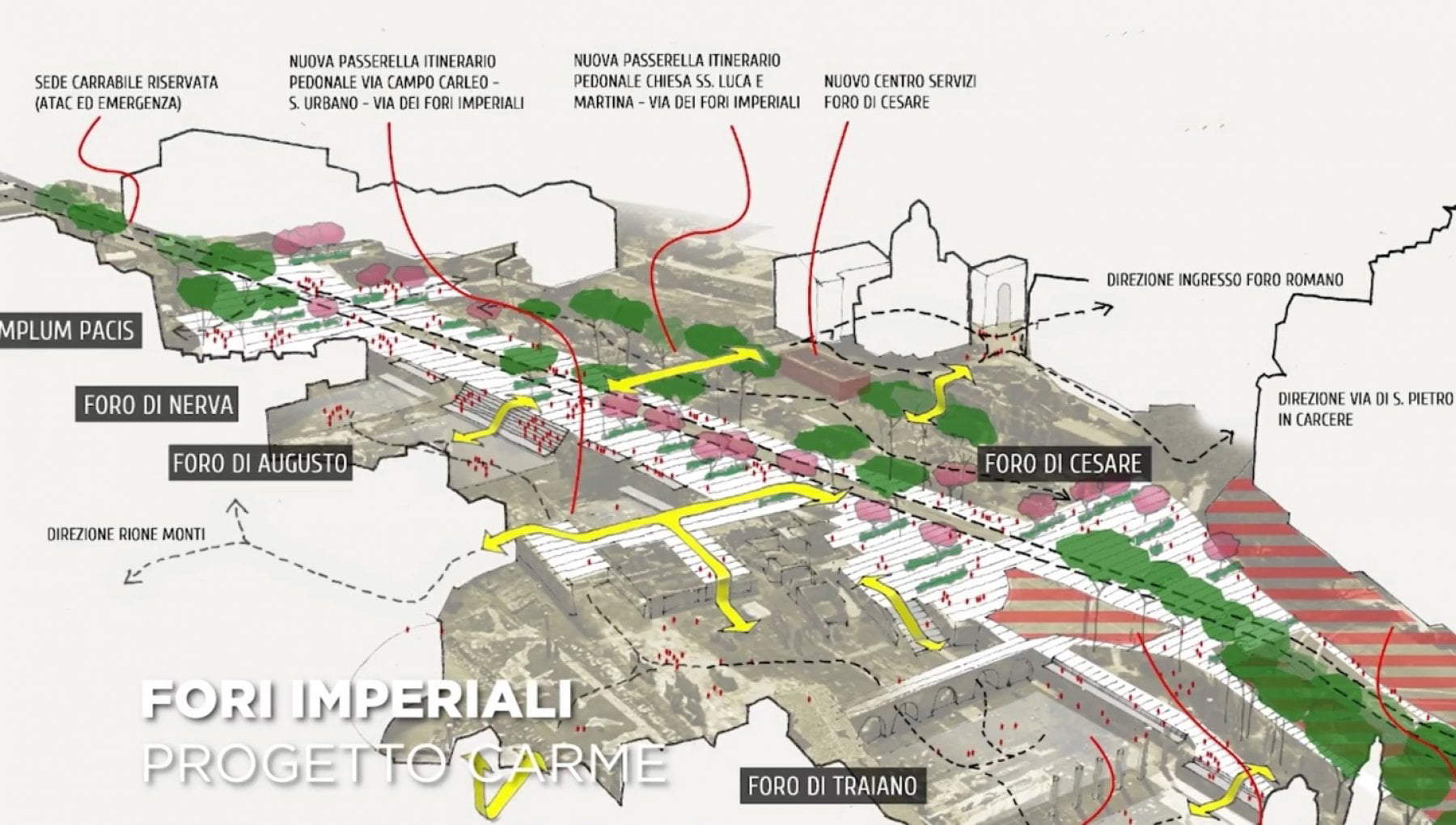Leaving Via dei Fori Imperiali in Rome intact? A reactionary and anachronistic idea
If there is to be found a real havoc that threatens to be wrought around the redevelopment of Rome’s Via dei Fori Imperiali, it could be nimbly identified in the maintenance of the status quo. It must be premised, of course, that a smoky blanket shrouded, even before it was scuttled, the project for the new redevelopment of the narrow street, opened under the fascist regime, that connects Palazzo Venezia to the Colosseum. Few details have been leaked so far: the “Centro Archeologico Monumentale” (CArMe) project had yet to be presented to the citizenry, and on paper it was still very much open, so much so that the actual realization was to go through an international public competition, conceived to attract to Rome the greatest architects, urban planners and designers who would deliver to the city and to everyone the new configuration of the most beautiful archaeological area in the world. Or rather: the competition will be there. But there will be no CArMe project as it had been known up to this point.
Unveiled in the fall of 2022, the project was based on the idea of “recognizing the ancient forums as contemporary squares,” as the preliminary report read. A project that was capable of “restoring the integral vision of the forum of Trajan, Augustus, Caesar, Nerva and the Templum Pacis, while also showing the most significant testimonies of the late antique, early medieval, medieval, renaissance and baroque phases.” A project that would intervene in the fabric that the opening of the Via dei Fori Imperiali had made difficult to read: transforming the ruins into a sequence of public spaces connected to the rest of the city, with the Via dei Fori Imperiali finally transformed into a pedestrian space consistent with the archaeological remains, into a succession of squares with overlooks, descents, new lighting, increased greenery, the possibility of hosting exhibitions and events, the maintenance of a couple of lanes reserved for public transport so as not to compromise urban mobility. The CArMe, although not yet presented in detail, had the potential to seize the legacy of the visionary “Progetto Fori,” a proposal that the then archaeological superintendent Adriano La Regina had worked on in the 1970s, along with distinguished figures in culture, architecture and urban planning, such as Antonio Cederna, Italo Insolera, Vezio De Lucia and others: the idea, then as now, was to return the Forums to citizens and visitors, without transforming them into what rhetoric has accustomed us to calling an “open-air museum,” without fencing off the archaeological area thus disconnecting it from the rest of the city, but integrating it into the urban fabric, making it a space that was not only legible, but also livable.
The Forum Project began to die out in 1981, after the passing of Mayor Luigi Petroselli, who had strongly supported it. CArMe could have been an opportunity to finally give shape to the dream of an area of the Forums transformed into a public space in the heart of downtown Rome. Undergoing a profound revision of a road that was by now oversized and therefore anachronistic, or simply “useless” if we want to use an adjective used by Vezio De Lucia (and the intervention, moreover, would not have distorted the layout nor the perspective axis, since the CArMe envisaged that one would continue to see the Colosseum from Piazza Venezia, and thus would not have substantially affected the twentieth-century stratification), to recompose the underlying archaeological fabric, partly buried precisely by Via dei Fori Imperiali, and rejoin it with the rest of the historic center. It is in essence the exact opposite of the “Disneyland” or “amusement park for tourists” of which those who do not want Via dei Fori Imperiali to be touched have improperly spoken, and who have evidently misunderstood the spirit that animates the project, or have simply dismissed it as hearsay. An area of the Forums handed back to the Romans (who now, moreover, tend to avoid it) goes in the opposite direction than a hypothetical toyland for casual visitors. Especially since for now little more than an idea was being talked about.


We probably won’t see any of this, however. The Roman summer has been enlivened by a lashing campaign by the Messenger , which, for reasons that frankly escape us, has been beating hard, and with almost daily frequency, against the CArMe project, alternately branded as a “havoc,” an “outrage” (it is not clear to whom or to what), an intervention that would “deface” the city’s oldest core. Then, on August 9, colleagues at the Roman newspaper could finally breathe a sigh of relief: “the Imperial Fora are saved,” they headlined, giving news of a summit that brought together Culture Minister Gennaro Sangiuliano, Mayor Roberto Gualtieri, Colosseum Director Alfonsina Russo, Capitoline Superintendent Claudio Parisi Presicce and Special Superintendent Daniela Porro, and in which a decision was made for the substantial preservation of the features of the street wanted by Mussolini. “The Imperial Fora will be enhanced but not distorted,” read the piece signed by Ferdinando Magliaro: “no posticcio squares” (?), “no gazebos,” “no planters” (as if they were permanent interventions!), “no completely decontextualized contemporary art installations” (how do you know they will be “decontextualized” if they have not yet been designed?), “no Archeotram” (when, in fact, the idea of the forum tramway was being eliminated from the Urban Sustainable Mobility Plan as early as early 2022). Yes, instead, to the street “remaining as it is today, with no retouches to the roadway dimensions”: “resurfaced sidewalks, excavated edges, and all the pine trees that over the years have collapsed or been cut down due to end of life or illness will be replanted.”
In essence, Via dei Fori Imperiali will not be touched. It is then unclear what the point of an international competition is, if the maximum allowed will be redoing the sidewalks and replanting the pines. Above all, it is not understood why this choice was made. It is not clear why Via dei Fori Imperiali should be left intact: it is a reactionary and anachronistic idea. There are no reasonable reasons for it. The CArMe is inspired, as we have seen, by a project that influential, far-sighted, visionary personalities worked on. It was still a kind of master plan, not yet an executive plan: certainly, the unknown of the eventual gap between idea and execution still existed, but evidently even the idea did not meet with approval. And it was anything but an offense to Rome. The Bianchi Bandinelli, Italia Nostra Roma and Carteinregola associations also sent a letter to Mayor Gualtieri asking for the reasons for a decision that for now appears to be supported, according to the missive, by the “one and only purpose of serving the holding of military parades.” If this is indeed the reason, the decision to abandon the original project takes on further curious, if not grotesque, contours. But do you really give up a project designed for the future of Rome because you cannot find another place for the June 2 parade? Then, as Giovanni Caudo, chairman of the Rome Municipality’s PNRR Special Commission, wrote, if everything is left as it is it would at least be necessary to have the courage to do the only thing that would make sense to do with a substantially unaltered Via dei Fori Imperiali: “reopening it to traffic,” “at least that would justify the preservation of the roadway.”
Then there is another issue: the redevelopment of Via dei Fori Imperiali has already been included in the Dpcm of last June 8 approving the proposed detailed program of interventions related to the Jubilee celebrations of 2025. For intervention number 23, “pedestrianization and redevelopment Via dei Fori Imperiali,” 10.5 million euros have already been allocated: “the objective of the arrangement for the future new area of the Imperial Forums,” reads the annex to the decree, “is that of a spatial, functional and monumental integration of the contemporary level with the archaeological one, for the realization of a new scene of public space and for the transformation of the ancient forums into contemporary, non-museum-ized squares open to city life.” The decree also specifies how to achieve the goal: descents and public squares located on the archaeological level, overlooks, possibility of organizing cultural events. Then there are other allocations: one and a half million euros for the “enhancement of the urban image” of the CArMe archaeological ring (i.e., the fittings, street furniture, and works of art that will serve to define the unified image of the area), 1.8 million euros for the expansion of the service center in Via del Tempio della Pace, three hundred thousand euros for the international competition, and more. It is then unclear how the idea of creating “an integration of the contemporary level with the archaeological level for the creation of a new scene of public space” can be followed up if it will not be possible to touch anything. Well then, the associations do well to ask the mayor for the disclosure of both projects in their details, both the original and the modified one, so that we can have a more informed discussion.
For now, all that remains is to wait for the next developments, in the hope that the project will not be limited to handing back Via dei Fori Imperiali as it is, with only a few sidewalks redone and a few pine trees replanted. And with the knowledge that the true arrangement of the street is only postponed, since an intervention that truly integrates the street with the archaeological area is inevitably written into Rome’s future. Antonio Cederna wrote as early as 1981: “Dismantling the asphalt, bringing the imperial forums back into the light, means removing the antiquities from the trivial use that has been made of them up to now, reduced as they have been to mere scenic backdrops sunk into basins, and restoring to them the role of protagonists of the urban scene, in vital and not superficial and rhetorical contact with the people.” This would serve a modern Rome.
Warning: the translation into English of the original Italian article was created using automatic tools. We undertake to review all articles, but we do not guarantee the total absence of inaccuracies in the translation due to the program. You can find the original by clicking on the ITA button. If you find any mistake,please contact us.




























